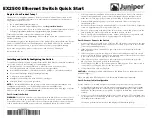
b.
Run the
ntp-service authentication-keyid
command to set an NTP
authentication key.
c.
Run the
ntp-service reliable authentication-keyid
command to declare that the
key is reliable.
2.
Add a VLAN L3 interface.
a.
Run the
vlan
command to create a VLAN.
b.
Run the
port vlan
command to add an upstream port to the VLAN so that the
user packets carrying the VLAN tag are transmitted upstream through the
upstream port.
c.
In the global config mode, run the
interface vlanif
command to create a VLAN
interface, and then enter the VLAN interface mode to configure the L3 interface.
d.
Run the
ip address
command to configure the IP address and subnet mask of the
VLAN interface so that the IP packets in the VLAN can participate in the L3
forwarding.
3.
Run the
ntp-service broadcast-client
command to configure the host as the NTP
broadcast client.
----End
Example
Assume the following configurations: MA5616 functions as the NTP client, snooping on the
broadcast packets sent from the server through IP address 10.10.10.20/24 of the L3 interface of
VLAN 2 and synchronizing the local clock with the clock on the broadcast server. To perform
these configurations, do as follows:
huawei(config)#
vlan 2 standard
huawei(config)#
port vlan 2 0/0 0
huawei(config)#
interface vlanif 2
huawei(config-if-vlanif2)#
ip address 10.10.10.20 24
huawei(config-if-vlanif2)#
ntp-service broadcast-client
huawei(config-if-vlanif2)#
quit
3.9.1.3 Configuring the NTP Multicast Mode
This topic describes how to configure the MA5616 for clock synchronization in the NTP
multicast mode. After the configuration is complete, the server periodically multicasts clock
synchronization packets through a specified port, and functions as a client to listen to the
multicast packets sent from the server and synchronizes the local clock according to the received
multicast packets.
Prerequisites
Before configuring the NTP multicast mode, make sure that the network interface and the routing
protocol of the MA5616 are configured so that the server and the client are reachable to each
other at the network layer.
Context
In the multicast mode, the server periodically sends clock synchronization packets to the
multicast address configured by the user. The default NTP multicast address 224.0.1.1 is used
if the multicast address is not configured. The Mode field of clock synchronization packet is set
to 5 (multicast mode). The client listens to the multicast packets sent from the server. After
receiving the first multicast packet, the client exchanges NTP packet whose mode fields are set
SmartAX MA5616 Multi-service Access Module
Configuration Guide
3 Basic Configuration
Issue 04 (2011-10-30)
Huawei Proprietary and Confidential
Copyright © Huawei Technologies Co., Ltd.
73
















































